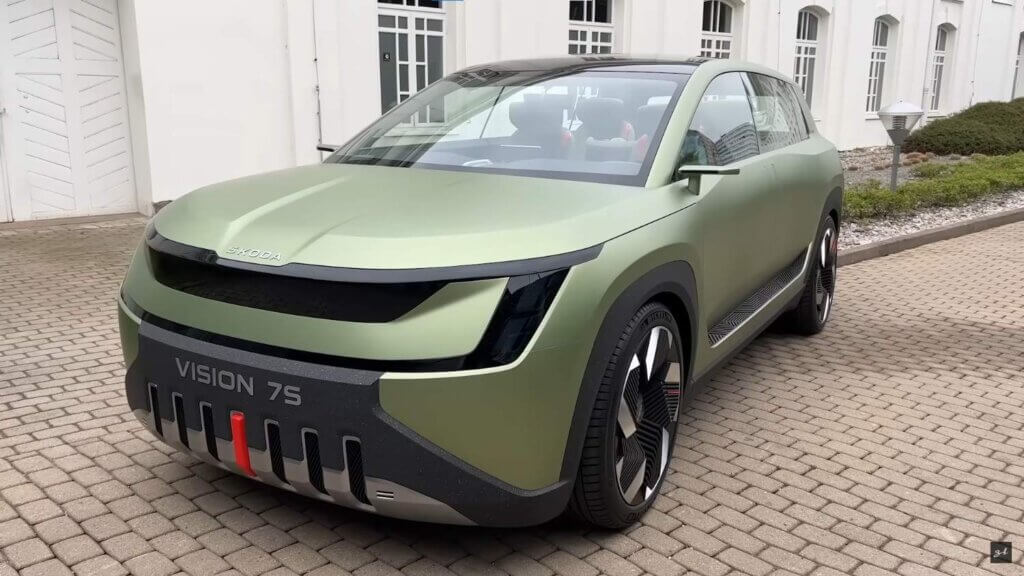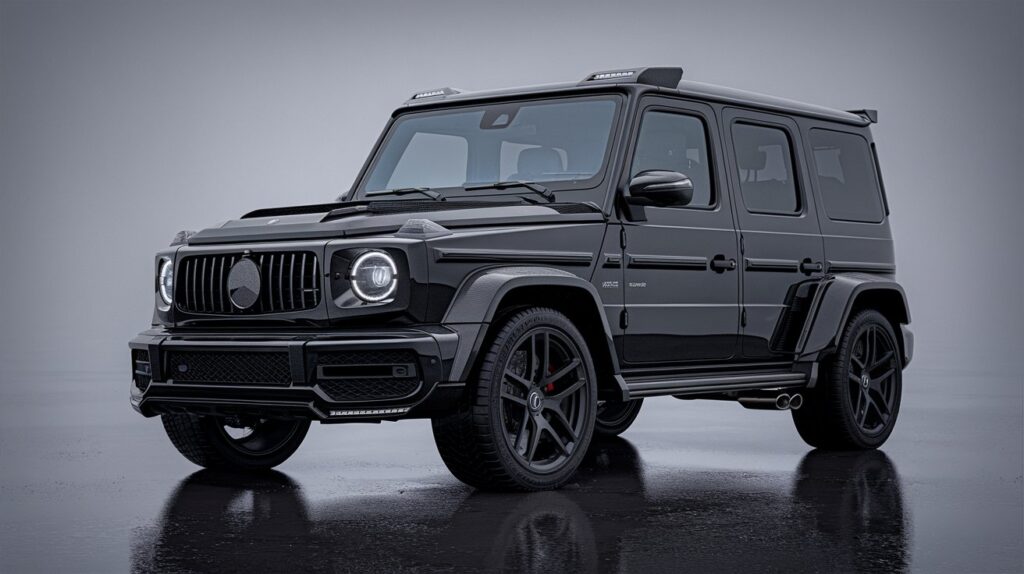Škoda’s Bold Electric Future Takes Shape
The automotive landscape is rapidly evolving, with electric vehicles transitioning from niche alternatives to mainstream options. In this transformative era, Škoda Auto is making a decisive statement with its Vision 7S concept—a vehicle that represents far more than just another entry in the burgeoning electric SUV segment. This family-oriented seven-seater showcases Škoda’s new design language and technological approach while offering a glimpse into the Czech manufacturer’s electric future.
The Vision 7S isn’t merely a concept exercise destined for museum displays. Rather, it previews a production model that Škoda has confirmed will launch by 2026 as part of its ambitious strategy to introduce three new electric vehicles by that year. With its distinctive aesthetic approach, innovative interior configuration, and promise of substantial electric range, the Vision 7S merits serious attention from consumers and industry observers alike.
What makes this concept particularly significant is how it balances practical family transportation needs with cutting-edge technology and sustainable design principles. Let’s examine what this visionary vehicle offers and what it signals about Škoda’s direction in the rapidly electrifying automotive marketplace.
Škoda’s New Design Language: Modern Robustness
Tech-Deck Face: A Bold New Identity
The Vision 7S debuts Škoda’s completely reimagined design philosophy, which the brand calls “Modern Solid.” This fresh aesthetic direction represents the most dramatic shift in Škoda’s visual identity in recent history. The front end introduces what Škoda calls a “Tech-Deck Face,” replacing the traditional radiator grille with a darker, more integrated panel that houses various sensors and cameras essential for advanced driver assistance systems.
This new face features narrow, T-shaped headlights that create a distinctive light signature, instantly recognizable day or night. The headlights are complemented by seven vertical air intakes that enhance the vehicle’s bold presence while serving practical cooling functions for the battery and braking systems.
Robust Exterior with Practical Elements

The Vision 7S’s exterior design balances aesthetic appeal with practical functionality—a hallmark of Škoda’s design philosophy. The concept features a robust, protective appearance with matte paint, rugged protective elements, and aerodynamically efficient 22-inch wheels that enhance both visual appeal and range efficiency.
Flush door handles contribute to the clean side profile while improving aerodynamics. The vehicle’s substantial ground clearance suggests light off-road capability, though this remains primarily an urban and highway-focused family vehicle rather than a dedicated off-roader.
One of the most interesting design elements is the roof, which incorporates integrated roof rails and what Škoda calls “roof carriers” that can be used for mounting exterior accessories. These carriers also accommodate visual light strips that indicate the battery charging status from outside the vehicle—a thoughtful touch that adds both functionality and visual distinction.
Interior Innovation: Two Distinct Modes for Modern Living
Revolutionary Seating Configuration
Perhaps the most remarkable aspect of the Vision 7S is its interior design, which offers a genuinely fresh approach to cabin architecture. The vehicle features seven individual seats arranged in a unique 2-3-2 configuration. The central middle-row seat is specially designed to accommodate a child safety seat, which can be mounted facing rearward while still allowing easy access to the child from either the first or third row.
This thoughtful arrangement reflects Škoda’s understanding of modern family dynamics and prioritizes child safety without compromising adult comfort or convenience.
Driving and Relaxing Modes

The Vision 7S introduces a transformative interior that can switch between two distinct configurations: Driving and Relaxing. In Driving mode, all controls are positioned in their traditional locations, with the 14.6-inch vertically oriented central touchscreen providing access to infotainment functions.
When parked, the vehicle can transition to Relaxing mode. The steering wheel and instrument cluster slide forward, the front seats rotate inward for a more conversational arrangement, and the central touchscreen rotates to a horizontal orientation better suited for watching content. This intelligent reconfiguration transforms the vehicle from a transportation device to a social space—a recognition that modern vehicles serve as extensions of our living environments rather than mere conveyances.
Sustainable Materials and Thoughtful Details
Škoda’s commitment to sustainability is evident throughout the Vision 7S’s interior. The cabin utilizes recycled materials extensively, including recycled-tire floor mats and seat covers made from sustainable materials. Even the child seat is manufactured using 3D-knitted recycled polyester yarns.
The minimalist dashboard features touch-sensitive controls integrated into haptic control panels, reducing visual clutter while maintaining intuitive operation. Ambient lighting adds atmosphere while also serving functional purposes, such as indicating charging status or highlighting safety features.
Storage solutions abound, with magnetic areas where metal items can be secured without additional accessories, and backpacks that integrate directly into the seatbacks—another example of Škoda’s “Simply Clever” approach to practical design.
Electric Powertrain: Performance Meets Practicality
Battery and Range Capabilities
The Vision 7S is built on the Volkswagen Group’s MEB platform, which underpins various electric vehicles across the corporate portfolio. Škoda has confirmed that the concept houses an 89 kWh battery pack, promising a substantial WLTP range of up to 600 kilometers (approximately 373 miles).
This generous range positions the production version competitively among long-range electric SUVs, addressing one of the primary concerns of potential EV adopters—range anxiety. The significant battery capacity suggests that even in real-world driving conditions, which typically yield lower ranges than official WLTP figures, the production model should offer comfortable long-distance capability.
Charging Technology
Fast-charging capability is essential for practical electric vehicle operation, and the Vision 7S doesn’t disappoint in this regard. Škoda claims the vehicle can accept charging rates of up to 200 kW, enabling rapid recharging when connected to suitable high-power DC fast chargers.
At these charging rates, the battery can reportedly charge from 10% to 80% in approximately 30 minutes—quick enough for convenient rest stops during longer journeys. This combination of substantial range and quick charging capability makes the Vision 7S a viable option for families who regularly undertake longer trips.
Performance Specifications
While Škoda hasn’t released complete performance specifications for the Vision 7S, we can make educated projections based on similar MEB-platform vehicles. Given the substantial battery capacity and the physical size of this seven-seat SUV, we can expect:
- Estimated horsepower: 295-350 hp (likely dual-motor AWD configuration)
- Estimated torque: 460-510 Nm
- Projected 0-100 km/h acceleration: 6.5-7.2 seconds
- Top speed: Likely electronically limited to 160-180 km/h for efficiency reasons
These projections would place the production version of the Vision 7S in the sweet spot for family-oriented electric SUVs—offering sufficient performance for confident highway merging and passing while prioritizing efficiency over sports-car acceleration.
Technology Integration: Connected and Intuitive
User Interface and Connectivity
The central interface in the Vision 7S consists of a 14.6-inch rotating touchscreen supplemented by an 8.8-inch digital instrument cluster. This primary display utilizes a simplified interface with large, clearly labeled icons designed to minimize distraction while driving.
Connectivity features would include wireless smartphone integration, over-the-air software updates, and remote vehicle monitoring and control via a smartphone app. The production model will likely incorporate Škoda’s latest infotainment system with enhanced voice control capabilities, allowing drivers to keep their hands on the wheel and eyes on the road.
Advanced Driver Assistance Systems
Safety technology in the Vision 7S appears comprehensive, with numerous cameras and sensors integrated into the exterior design. These would support a full suite of advanced driver assistance systems, likely including:
- Adaptive cruise control with stop-and-go functionality
- Lane keeping assistance and lane centering
- Autonomous emergency braking with pedestrian and cyclist detection
- Blind spot monitoring with rear cross-traffic alert
- Automated parking assistance
These systems represent the current state of the art in vehicle safety technology and would position the production version of the Vision 7S competitively in terms of driver assistance features.

Market Positioning and Production Timeline
Confirmed Production Plans
According to official statements from Škoda Auto, the Vision 7S concept previews a production model that will arrive by 2026, not 2025 as sometimes reported. This vehicle will be one of three new electric models Škoda plans to launch before 2026, alongside a compact car and a compact SUV. Together with the existing Enyaq iV and Enyaq Coupé iV, these will form a five-model electric lineup as Škoda accelerates its transition toward electrification.
This timeline aligns with the Volkswagen Group’s broader electrification strategy and suggests that Škoda is positioning itself aggressively in the electric vehicle market, particularly in the family-oriented segment where its practical approach to design could offer meaningful differentiation.
Competitive Landscape
When it reaches production, the Vision 7S-based model will enter an increasingly crowded electric SUV marketplace. Its seven-seat configuration will place it in competition with vehicles like the Tesla Model X, Mercedes-Benz EQB, and upcoming seven-seat versions of other electric SUVs. However, Škoda’s traditional value proposition—offering premium features and solid engineering at more accessible price points—could create a compelling option in this segment.
The production model will likely maintain much of the concept’s innovative interior design while potentially simplifying some of the more extreme elements for cost and manufacturing practicality. The 2025 Škoda Kodiaq provides some indication of how Škoda approaches production-ready family SUVs, though the electric model will represent a more radical departure from convention.
Expected Pricing and Positioning
While precise pricing remains unannounced, Škoda’s market positioning suggests the production Vision 7S will be priced competitively relative to premium electric SUVs. Based on current electric vehicle pricing trends and Škoda’s typical market approach, we might expect the base model to start around €50,000-€55,000 in European markets, with higher-specification versions approaching €70,000.
This would position the vehicle below premium-branded competitors while offering similar space and technology—a value proposition consistent with Škoda’s broader market strategy.
Practical Considerations for Potential Buyers
Interior Space and Versatility
As a dedicated seven-seater, the Vision 7S promises exceptional versatility for families and those who regularly transport multiple passengers. The innovative seating arrangement, with its special accommodation for child seats, demonstrates thoughtful consideration of real-world family needs.
Cargo capacity figures haven’t been specified for the concept, but given the vehicle’s substantial dimensions and the flexibility of its seating configuration, we can expect competitive luggage space. The production version will likely feature Škoda’s typical array of “Simply Clever” storage solutions throughout the cabin, enhancing everyday usability.
Ownership Experience
Electric vehicle ownership differs significantly from that of conventional internal combustion vehicles, with different maintenance requirements and operational considerations. The Vision 7S’s production version will likely benefit from Škoda’s growing experience with electric vehicles, exemplified by the 2025 Škoda Octavia RS and its electrification strategy.
Maintenance requirements for electric vehicles are generally lower than for conventional vehicles, with fewer moving parts and fluid changes required. However, battery health management becomes an important consideration, with Škoda likely to offer substantial battery warranties to reassure customers about long-term reliability.
Pros and Cons: A Balanced Assessment
The Škoda Vision 7S concept, and its forthcoming production version, offers numerous compelling attributes but isn’t without potential drawbacks. Understanding these can help potential buyers make informed decisions when the production model eventually arrives.
On the positive side, the Vision 7S showcases impressive range capabilities, potentially reaching 600 km on a single charge—addressing a primary concern for electric vehicle skeptics. Its innovative interior configuration demonstrates genuine thought leadership, particularly the family-focused seating arrangement and dual-mode cabin functionality. The integration of sustainable materials throughout the vehicle aligns with environmentally conscious consumers’ values, while Škoda’s reputation for value means the production version will likely offer competitive pricing relative to feature content.
However, several considerations might give potential buyers pause. As a new architecture for Škoda, the production version might experience first-generation teething issues that more established electric platforms have already resolved. The substantial battery pack, while offering excellent range, contributes to overall vehicle weight, potentially affecting handling dynamics and efficiency. Additionally, despite growing rapidly, the charging infrastructure in many regions remains less developed than traditional fueling networks, requiring more trip planning for longer journeys. Finally, the innovative rotating screen and dual-mode interior, if carried to production, would add mechanical complexity that could present long-term reliability concerns.
Conclusion: A Compelling Vision of Electric Family Mobility
The Škoda Vision 7S concept represents a thoughtful and comprehensive approach to electric family transportation. By combining substantial electric range with innovative interior design and practical features, Škoda has created a concept that addresses real consumer needs rather than merely showcasing technology for its own sake.
When it reaches production by 2026, this seven-seat electric SUV will enter an increasingly competitive marketplace. However, its unique combination of family-focused design, competitive range, and Škoda’s value-oriented approach could carve out a meaningful position in the electric SUV segment.
For families considering the transition to electric mobility who need space for multiple passengers and their belongings, the production version of the Vision 7S will merit serious consideration. Its thoughtful approach to interior design and focus on practical innovation exemplify Škoda’s understanding of how vehicles integrate into modern family life.
As the automotive world continues its electric transition, concepts like the Vision 7S demonstrate that electric vehicles need not represent a compromise in utility or functionality. Instead, they can offer new possibilities for reimagining how we use and interact with our vehicles—a vision of mobility that’s not just electrified but genuinely evolved.

